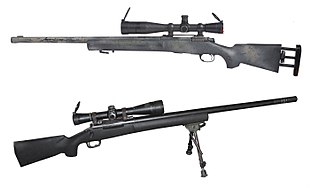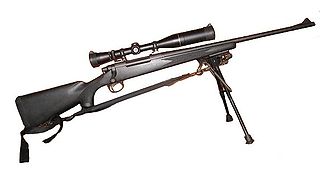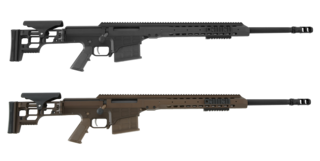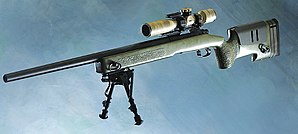
Bolt-action is a type of manual firearm action that is operated by directly manipulating the bolt via a bolt handle, which is most commonly placed on the right-hand side of the firearm.

A sniper rifle is a high-precision, long-range rifle. Requirements include high accuracy, reliability, and mobility, concealment, and optics, for anti-personnel, anti-materiel and surveillance uses by military snipers. The modern sniper rifle is a portable shoulder-fired rifle with either a bolt action or semi-automatic action, fitted with a telescopic sight for extreme accuracy and chambered for a high-ballistic performance centerfire cartridge.

The M24 Sniper Weapon System (SWS) or M24 is the military and police version of the Remington Model 700 rifle, M24 being the model name assigned by the United States Army after adoption as their standard sniper rifle in 1988. The M24 is referred to as a "weapon system" because it consists of not only a rifle, but also a detachable telescopic sight and other accessories.
The Accuracy International Arctic Warfare rifle is a bolt-action sniper rifle designed and manufactured by the British company Accuracy International. It has proved popular as a civilian, police, and military rifle since its introduction in the 1980s. The rifles have some features that improve performance in very cold conditions without impairing operation in less extreme conditions.

The United States Marine Corps Designated Marksman Rifle is a semi-automatic, gas-operated rifle chambered for the 7.62×51mm NATO cartridge. It is a modified version of the M14 rifle formerly used by the United States Marine Corps. The USMC Precision Weapons Section at Marine Corps Base Quantico built all DMRs.

The Remington Model 700 is a series of bolt-action centerfire rifles manufactured by Remington Arms since 1962. It is a development of the Remington 721 and 722 series of rifles, which were introduced in 1948. The M24 and M40 military sniper rifles, used by the US Army and Marine Corps, respectively, are both based on the Model 700 design.
The Winchester Model 70 is a bolt-action sporting rifle. It has an iconic place in American sporting culture and has been held in high regard by shooters since it was introduced in 1936, earning the moniker "The Rifleman's Rifle". The action has some design similarities to Mauser designs and it is a development of the earlier Winchester Model 54, itself being based on a Mauser 98–type action.

A designated marksman rifle (DMR) is a modern scoped high-precision rifle used by infantry in the designated marksman (DM) role. It generally fills the engagement range gap between a service rifle and a dedicated sniper rifle, at around 300–600 metres (330–660 yd).

The M110 Semi Automatic Sniper System is an American semi-automatic sniper rifle that is chambered for the 7.62×51mm NATO round. It is manufactured by Knight's Armament Company, developed from the Knight's Armament Company SR-25, and adopted by the U.S. military following the 2005 US Army Semi-Automatic Sniper Rifle competition.

The Marine Scout Sniper Rifle (MSSR) is a Philippine semi-automatic designated marksman rifle developed by the Philippine Marine Corps for their Marine Scout Snipers. Designed in the mid-1990s to replace severely-outdated battle rifles then used as marksman rifles, the MSSR is essentially an M16A1 that has been heavily modified and accurized to serve as a marksman rifle.

The T93 Sniper Rifle is a 7.62×51mm bolt-action rifle designed and manufactured in Taiwan.
The M39 Enhanced Marksman Rifle is a semi-automatic, gas-operated designated marksman rifle chambered for the 7.62×51mm NATO cartridge. It is a modified and accurized version of the M14 rifle used by the United States military, in a similar vein to the Mk 14 Enhanced Battle Rifle. It is based on the United States Marine Corps Designated Marksman Rifle (DMR), which it replaced. It is manufactured by Sage International and maintained by the USMC's Precision Weapons Section.
The Parker-Hale Model 82 (M82) is the military version of the Parker-Hale 1200TX target rifle; it was accepted for service by several nations for both military and police use. In appearance and design terms the Model 82 is an entirely conventional sniping weapon. It uses a manual bolt action the same as the classic Mauser 98 rifle, allied to a heavy free-floating barrel chambered for the 7.62×51mm NATO round. The barrel weighs 1.98 kg and is manufactured from chrome molybdenum steel. The Model 82 has an integral four-round magazine and an entirely self-contained trigger unit which can be adjusted as required.

The M2010 Enhanced Sniper Rifle (ESR), formerly known as the XM2010 and M24 Reconfigured Sniper Weapon System, is a sniper rifle developed by PEO Soldier for the United States Army. It is derived from and replaced the M24 Sniper Weapon System, and was designed to give snipers longer range in the mountainous and desert terrain of the War in Afghanistan. After winning a competitive bidding process, Remington was awarded the production contract for up to 3,600 weapons. The Army had anticipated sending the upgraded weapons to deployed snipers in late 2010, but later expected fielding would happen in January 2011. The M2010 fires .300 Winchester Magnum (7.62×67mm) ammunition, which offers about 50 percent more effective range than the M24's 7.62×51mm NATO. This chambering to dimensionally larger cartridges is possible because the M24 was designed to use the "long action" bolt version of the Remington 700 receiver for cartridges up to 3.34 inches (84.84 mm) in overall length.

The Barrett MRAD is a bolt-action sniper rifle designed by Barrett to meet the requirements of the SOCOM PSR. The MRAD is based on the Barrett 98B and includes a number of modifications and improvements. The Barrett MRAD was named the 2012 Rifle of the Year by the NRA.
The Crazy Horse rifle or M14SE is a semi-automatic designated marksman rifle based on the M14 rifle. It is chambered for the 7.62×51mm NATO cartridge and is built by Smith Enterprise Inc.

The MK 13 rifle is made using the Accuracy International Chassis System (AICS) version 2.0 mated to a long action Remington 700 receiver. The AICS 2.0 folding stock reduces the rifle's overall length by 210 mm (8.3 in) when folded and adds 0.2 kg (0.44 lb) to the rifle's total weight. The rifle has a cheekpiece design that adjusts sideways and for height for optimal cheek position when using night vision equipment or telescopic sights with large objective lenses. There is also a quick-adjust cheek-piece option that has a spring-loaded cheek-piece in conjunction with a quick-adjust butt plate. The side panels are made from a high-strength polymer and are available in the colors olive drab, dark earth or black. Sling attachment points are mounted on each side of the rifle, so it can be carried flat against the back and used comfortably by left- and right-handed users. A front attachment point is situated below the fore-end and can be used to anchor a target-style sling or replaced by an adapter for a Harris bipod.















